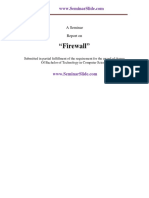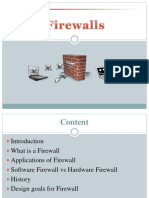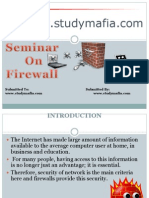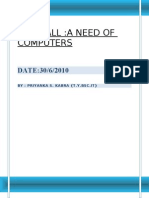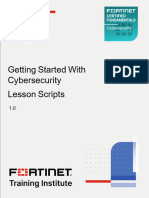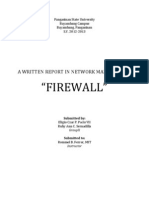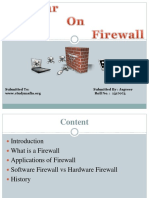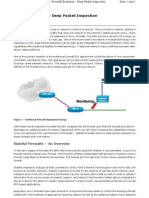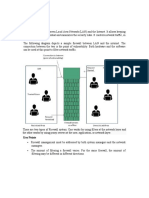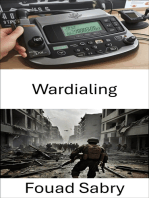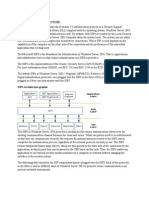Layer7 Application Firewalls
Layer7 Application Firewalls
Uploaded by
pratikchat89Copyright:
Available Formats
Layer7 Application Firewalls
Layer7 Application Firewalls
Uploaded by
pratikchat89Copyright
Available Formats
Share this document
Did you find this document useful?
Is this content inappropriate?
Copyright:
Available Formats
Layer7 Application Firewalls
Layer7 Application Firewalls
Uploaded by
pratikchat89Copyright:
Available Formats
2010 White Paper Series
Layer 7 Application Firewalls
Project: Layer Seven Firewalls Client: Educational Revision: 1 0 Author: Matthew Ruck
Introduction
The firewall, the first line of defense in many network security plans, has existed for decades. The purpose of the firewall is straightforward; permit authorized data to enter and exit the trusted network while preventing unauthorized traffic from doing so. Interestingly, the makeup and methodology of the firewall has not changed as rapidly as the systems and applications it intends to protect. Over the years, enhancements certainly have occurred within perimeter security; however, the overall methodology of the firewall has not radically changed. Present-day threats in information security require a new firewall technology called application layer filtering, otherwise known deep packet inspection. The purpose of this paper is to describe why application firewalls are quickly becoming a requirement for all corporate computer networks.
Traditional Firewalls
Before detailing application firewall functions and capabilities, it is important to understand how traditional firewalls behave. Since their inception, firewalls have been driven by rules and policies codified by a communications engineer. Most firewalls in use today operate by the session (sender / recipient), and by the packet. Firewalls receive packets of data, which is comprised of header information, and the payload, which is the actual data intended for transmission. Traditional firewalls read information from the packet header that determines what the firewall ought to do with the packet (Ingham, 2002). The rules that determine what the packet filtering firewall is going to do- the policies- are largely static in nature. Put into information technology terms, traditional firewalls operate at the data link, network, and transport layers of the Open System Interconnection (OSI) model (Proch, 2009). Accordingly, a traditional firewall can look into the header of a packet and determine basic information; such as where the packet came from, where it wants to go, and what port it intends to travel on. For example, a packet coming into a firewall might have a header that indicates that it originated from a specific IP number A, intends to deliver its payload to IP number B and is traversing transmission port protocol (TCP) number twenty-three (Clarke, 2009). Based on this information, the firewall then decides either to allow or deny access. This relatively simple rule-based system has worked for a long time, but is quickly becoming only the starting point in gateway threat protection.
2010 designDATA, INC.
NOT FOR REPRINT OR COMMERCIAL USE
PAGE | 2
Project: Layer Seven Firewalls Client: Educational Revision: 1 0 Author: Matthew Ruck
The New Threat
Today, malware, such as worms and bots, are entering networks on ports typically left open by most firewalls. Executable code can launch in a web browser over http port eighty, or via instant messenger using a remote procedure call (RPC). These ports provide services that cannot be turned off by most network administrators, thus leaving the network or security administrator in a precarious position. Structured Query Language (SQL) injection attacks are a good example of this situation. These attacks to a database back end occur from a website front end. The website front end invariably has insecure code that could be exploited by a hacker. Traditional firewalls have no way to fend off this attack, as the entire purpose of the site is to receive web hypertext end user requests via port 80 and secure socket layer (SSL - encrypted) port 443. Older generation firewalls will see these attacks as normal permissible surfing. A second example is the case of the Blaster Worm. This malicious code launched a distributed denial of service against Microsofts Windows Update Service. Blaster travelled over TCP port 135. This port is legitimately used for many Microsoft software applications (Greene, 2004). At the time of the attack, the prescribed remedy, shutting down the port, was not acceptable for many organizations. They needed 135 open.
Enter Application Firewalls
Application firewalls identify malicious traffic that traditional firewalls cannot. They accomplish this by performing deep packet inspection on the payload data contained in every packet. This data supplies a signature from which the firewall database determines to the application to which the data belongs. From this data, the firewall has an understanding of permissible actions this packet might take. The firewall can also determine if the packet is a wolf in sheeps clothing- malicious code masquerading as typical data. Applications firewalls offer a wide range of functions. In addition to the traditional analysis of layer two to layer four packet headers (traditional firewall rules), application firewalls should support all network protocol layers along with full packet payload analysis. These devices must be able to identify applications with static, dynamic, and negotiated protocol and port fields (Magalhaes, 2008). In other words, they must be capable of scanning the payload content to determine application type without reliance on headers that can be misleading. Application firewalls must keep a running, and constantly updated, list of application signatures logged for reference on the firewall
2010 designDATA, INC.
NOT FOR REPRINT OR COMMERCIAL USE
PAGE | 3
Project: Layer Seven Firewalls Client: Educational Revision: 1 0 Author: Matthew Ruck
(Proch, 2009). Finally, the devices need to keep up with the network interface. This is a real-time active scanning solution. The process of inspecting packets cannot interfere with data transmission.
Comparison to Network Intrusion / Prevention Devices
Readers may be asking themselves, what can this device do that a network intrusion / prevention device (NIDS / NIPS) cannot? These devices scan data in much in the same manner as application firewalls. The difference lies in the simplicity of the application firewalls over other content-inspection solutions. NIDS / NIPS devices require complex configurations, ongoing maintenance, and regular tuning to stay effective. Smaller shops may not have the expertise, manpower, or both required to deploy and maintain this sort of solution. Left unmaintained, very expensive NIDS / NIPS devices are nearly worthless. Conversely, application firewalls typically take immediate, automatic action once they identify a threat. Tim Green of Network World explains (2004), Intrusion-detection systems already do this [inspect payload data for malware], but their response is to trigger alerts for network administrators to decide whether suspicious traffic means an attack is really underway. Deep packet inspection firewalls differ in that they automatically take steps to block the attacks they detect (Green, 2004, p. 1). This automated function, in and of itself, most likely pays for itself in resource strapped IT departments.
Conclusion
Traditional firewalls have worked well for many years. They operate on basic rules that rely on packet header information. Historically, this information alone was enough to filter out those with a malicious intent. The device did not need to analyze payload data to make this determination. Unfortunately, the internet threat environment has irreversibly changed. Identification of data type by packet header and TCP port is no longer reliable. As demonstrated in this article, malicious code can easily masquerade itself as benign web traffic, or other legitimate web-based services. Preventing malicious code from entering the trusted network requires active inspection of data. Application aware firewalls identify data type by application signature. Armed with this intelligence, the device is in a superior position to determine how data should behave. Data that does not conform to the parameters of the device is not permitted to enter the trusted network. Application firewalls will quickly overtake traditional firewalls as the mandatory method for preventing network intrusions.
2010 designDATA, INC.
NOT FOR REPRINT OR COMMERCIAL USE
PAGE | 4
Project: Layer Seven Firewalls Client: Educational Revision: 1 0 Author: Matthew Ruck
References
Bradbury, D. (2009). Securing e-business with web application firewalls. Computer Weekly , 18. Clarke, J. (2009). Resilience under attack: Techniques for continuing online business in the face of security compromise. Journal of Business Continuity & Emergency Planning , 3(3), 222-226. Retrieved October 17, 2009 from Business Source Complete. Greene, T. (2004, February 2). The evolution of application layer firewalls . Retrieved October 17, 2009, from Network World: http://www.networkworld.com/news/2004/0202specialfocus.html Ingham, K. F. (2002). A History and Survey of Network Firewalls. The University of New Mexico, Computer Science Department , 1-42. Retrieved October 17, 2009 from Business Source Complete. Magalhaes, R. (2008, June 25). The Difference Between Application and Session Layer Firewalls. Retrieved October 17, 2009, from WindowsSecurity.com: http://www.windowsecurity.com/articles/Difference-Between-Application-Session-LayerFirewalls.html Proch, D. &. (2009). Plumb The Depths Of Deep Packet Inspection. Electronic Design , 57(16), 47-50. Retrieved October 17, 2009 from Business Source Complete.
2010 designDATA, INC.
NOT FOR REPRINT OR COMMERCIAL USE
PAGE | 5
You might also like
- Case Study On FirewallDocument4 pagesCase Study On Firewallsidhant kumarNo ratings yet
- Par T A - Multiple Choice Questions: Total 10 Mar KsDocument15 pagesPar T A - Multiple Choice Questions: Total 10 Mar KsyawahabNo ratings yet
- Firewall: The Internet Has Made Large Amounts of Information Available To The Average Computer User at HomeDocument13 pagesFirewall: The Internet Has Made Large Amounts of Information Available To The Average Computer User at HomeRakesh RanjanNo ratings yet
- "Firewall": A Seminar Report OnDocument15 pages"Firewall": A Seminar Report OnkumarNo ratings yet
- "Firewall": A Seminar Report OnDocument15 pages"Firewall": A Seminar Report OnkumarNo ratings yet
- "Firewall": A Seminar Report OnDocument15 pages"Firewall": A Seminar Report OnkumarNo ratings yet
- SE 4C03 Winter 2005 Firewall Design Principles: By: Kirk CraneDocument7 pagesSE 4C03 Winter 2005 Firewall Design Principles: By: Kirk CranePoulvilleNo ratings yet
- Firewall: What Is A Firewall?Document4 pagesFirewall: What Is A Firewall?Naveen AdaikkalamNo ratings yet
- Abstract On Network Security and CryptographyDocument13 pagesAbstract On Network Security and Cryptographytharun89% (9)
- FirewallDocument33 pagesFirewallhauwauibrahimmagaji532No ratings yet
- FirewallDocument22 pagesFirewallanmol_baliyan0767% (3)
- A Seminar Report On Firewall: Department of Computer Science & Engineering Assam Down Town UniversityDocument22 pagesA Seminar Report On Firewall: Department of Computer Science & Engineering Assam Down Town UniversityChao AmitNo ratings yet
- Department of Information TechnologyDocument15 pagesDepartment of Information TechnologyBiswajit MohantyNo ratings yet
- An Overview of Firewall Technologies: Keywords: Firewall Technologies, Network Security, Access Control, SecurityDocument9 pagesAn Overview of Firewall Technologies: Keywords: Firewall Technologies, Network Security, Access Control, SecurityAjitav BasakNo ratings yet
- Firewall:A Need of Computers: DATE:30/6/2010Document12 pagesFirewall:A Need of Computers: DATE:30/6/2010PRINCESSSONNo ratings yet
- Fire Wall: Gateway ServerDocument7 pagesFire Wall: Gateway ServerSultan Bayzid.No ratings yet
- INTRODUCTION pdf8766Document20 pagesINTRODUCTION pdf8766Yash KhedkarNo ratings yet
- Firewall PresentationDocument23 pagesFirewall PresentationmandeepNo ratings yet
- Firewalls: Paper Presentation OnDocument10 pagesFirewalls: Paper Presentation OnSonu SinghNo ratings yet
- CMP 313 Network Security MeasuresDocument4 pagesCMP 313 Network Security MeasuresnanyaobiefuleNo ratings yet
- White Paper For Firewall FirewallDocument9 pagesWhite Paper For Firewall FirewallgynxNo ratings yet
- Network Security Devices You Need To Know AboutDocument30 pagesNetwork Security Devices You Need To Know Aboutramya.gNo ratings yet
- WebDocument99 pagesWebhello i love u100% (2)
- Firewall ThesisDocument5 pagesFirewall Thesisaflnzraiaaetew100% (2)
- The Comprehensive Guide To Commercial Firewalls EbookDocument11 pagesThe Comprehensive Guide To Commercial Firewalls EbookPrahlad PatelNo ratings yet
- On Firewall ReportDocument12 pagesOn Firewall ReportPrincess Yashika0% (1)
- 84 10 26 PDFDocument14 pages84 10 26 PDFJenn MoodyNo ratings yet
- Getting Started in Cybersecurity 1.0 Lesson ScriptsDocument37 pagesGetting Started in Cybersecurity 1.0 Lesson ScriptskparraguezNo ratings yet
- "Firewall": A Written Report in Network ManagementDocument16 pages"Firewall": A Written Report in Network ManagementLeah Ann DiazNo ratings yet
- WWW - Oeclib.in: Odisha Electronics Control LibraryDocument24 pagesWWW - Oeclib.in: Odisha Electronics Control Librarymuneebrahat100% (1)
- Term Paper On FirewallsDocument6 pagesTerm Paper On Firewallsafdtxmwjs100% (1)
- Firewall (Computing) : Ubuntu GufwDocument6 pagesFirewall (Computing) : Ubuntu GufwKarthik RamanNo ratings yet
- Firewalls in Virtual Private Network-A New ApproachDocument14 pagesFirewalls in Virtual Private Network-A New ApproachkarthikNo ratings yet
- Submitted To: Submitted By: JagveerDocument22 pagesSubmitted To: Submitted By: JagveerabcdNo ratings yet
- Firewall Design Principles: Software Engineering 4C03Document8 pagesFirewall Design Principles: Software Engineering 4C03Ramachandran1707No ratings yet
- Distributed FirewallDocument41 pagesDistributed Firewallid.arun5260100% (5)
- Eb Converged It and OtDocument14 pagesEb Converged It and OtmykillerdroneNo ratings yet
- PrjectDocument4 pagesPrjectAli EmadNo ratings yet
- Literature Review On FirewallDocument8 pagesLiterature Review On Firewallbaduidcnd100% (1)
- What Is Firewall?: CISCO Pix Firewall Security Is Stateful Firewall. It Uses ASA TechnologyDocument22 pagesWhat Is Firewall?: CISCO Pix Firewall Security Is Stateful Firewall. It Uses ASA TechnologyLokesh Shanjeev100% (1)
- NSE 2 Firewall Script - ENDocument4 pagesNSE 2 Firewall Script - ENSezer ÖzavcıNo ratings yet
- Firewall DissertationDocument6 pagesFirewall DissertationHelpInWritingPaperSingapore100% (2)
- A Survey On The Different Firewall TechnologiesDocument3 pagesA Survey On The Different Firewall TechnologiessanketNo ratings yet
- Firewall PDFDocument28 pagesFirewall PDFsaby747No ratings yet
- Network Security Using FirewallsDocument11 pagesNetwork Security Using Firewallsashok_jinkala31100% (2)
- ANALYSIS_OF_FIREWALL_TECHNOLOGY_IN_COMPUDocument6 pagesANALYSIS_OF_FIREWALL_TECHNOLOGY_IN_COMPUaustineodhiambo52No ratings yet
- 2006032-VP0206 FirewallsDocument6 pages2006032-VP0206 Firewallsladyjay3710No ratings yet
- An Overview of Firewall TechnologiesDocument9 pagesAn Overview of Firewall TechnologiesMATHEUS LÁZARONo ratings yet
- w6 FirewallsDocument59 pagesw6 FirewallshajerpcNo ratings yet
- Nids STUDY PhaseDocument7 pagesNids STUDY Phaseyasir_yhNo ratings yet
- Firewall Master ThesisDocument7 pagesFirewall Master Thesisgogelegepev2100% (1)
- AniketpptDocument18 pagesAniketpptaniketshirale86No ratings yet
- CS GTU Study Material Presentations Unit-2 27092020040446AMDocument24 pagesCS GTU Study Material Presentations Unit-2 27092020040446AMHarsh JoshiNo ratings yet
- Siemens Mobility Whitepaper - Data Diodes Vs FirewallsDocument12 pagesSiemens Mobility Whitepaper - Data Diodes Vs FirewallsVibhav MehtaNo ratings yet
- Feleke Firewall Note 2023Document21 pagesFeleke Firewall Note 2023Abni booNo ratings yet
- Firewall Evolution Deep Packet InspectionDocument5 pagesFirewall Evolution Deep Packet Inspectionjimmy_2009No ratings yet
- Welcome To International Journal of Engineering Research and Development (IJERD)Document7 pagesWelcome To International Journal of Engineering Research and Development (IJERD)IJERDNo ratings yet
- CSS Unit-5Document28 pagesCSS Unit-5Vivek TripathiNo ratings yet
- The Palo Alto Networks Handbook: Practical Solutions for Cyber Threat ProtectionFrom EverandThe Palo Alto Networks Handbook: Practical Solutions for Cyber Threat ProtectionNo ratings yet
- Notice Coe Modnoticeified 2Document1 pageNotice Coe Modnoticeified 2pratikchat89No ratings yet
- Nufil Pi PDFDocument2 pagesNufil Pi PDFpratikchat89No ratings yet
- West Bengal University of Technology: Grade CardDocument1 pageWest Bengal University of Technology: Grade Cardpratikchat89No ratings yet
- Notification 1146-F - P - dt.14.02.11Document2 pagesNotification 1146-F - P - dt.14.02.11pratikchat89No ratings yet
- Blue-Green Deployments To AWS Elastic Beanstalk On The AWS CloudDocument27 pagesBlue-Green Deployments To AWS Elastic Beanstalk On The AWS CloudVictor Alan Perez GonzalezNo ratings yet
- Kerberos SSP ArchitectureDocument86 pagesKerberos SSP ArchitectureishuminiNo ratings yet
- Toverada, J. - Activity 1Document9 pagesToverada, J. - Activity 1Jovelyn ToveradaNo ratings yet
- 10 Meaningful Ways To Get More Twitter Followers - Sprout SocialDocument1 page10 Meaningful Ways To Get More Twitter Followers - Sprout SocialLKMs HUBNo ratings yet
- Unit III Society, Law and EthicsDocument54 pagesUnit III Society, Law and EthicsMcfirebreath SwattikNo ratings yet
- Materials Management MCQs and Answers 2021Document8 pagesMaterials Management MCQs and Answers 2021Fawa TubeNo ratings yet
- GSV5 SMS Commands EnglishDocument1 pageGSV5 SMS Commands EnglishElshan HuseynNo ratings yet
- Nillion WhitepaperDocument50 pagesNillion Whitepaperdelos kkNo ratings yet
- Network Pentesting Gaining Access 1 PDFDocument17 pagesNetwork Pentesting Gaining Access 1 PDFPhilippNo ratings yet
- Professional Practices MCQsDocument10 pagesProfessional Practices MCQsqamarNo ratings yet
- Security, Privacy & TrustDocument8 pagesSecurity, Privacy & Trustriaz ahamedNo ratings yet
- RC 4Document17 pagesRC 4CHAITANYA KRISHNA CHAUHANNo ratings yet
- Class 11 PDFDocument25 pagesClass 11 PDFelonreevemusk2kNo ratings yet
- Security in GSMDocument17 pagesSecurity in GSMmarwashable100% (2)
- Myrouter LocalDocument4 pagesMyrouter LocaltlinkrepeateNo ratings yet
- Ethical Hacking & Networks Security ToolsDocument5 pagesEthical Hacking & Networks Security Toolssandeepratnam343No ratings yet
- VTU Network and Cyber Security Module-3 (15ec835, 17ec835) - 2IN1Document20 pagesVTU Network and Cyber Security Module-3 (15ec835, 17ec835) - 2IN1jayanthdwijesh h p100% (2)
- Chapter 10 - Digital SelfDocument30 pagesChapter 10 - Digital SelfHANAH LORAINE LAUREANo ratings yet
- 150N Draft 802.11n Wireless Router Model # AR670W User's ManualDocument48 pages150N Draft 802.11n Wireless Router Model # AR670W User's ManualDario AcostaNo ratings yet
- Ebook Cyber Security Analyst (C3SA) AgungcoegDocument35 pagesEbook Cyber Security Analyst (C3SA) AgungcoegAgung Coeg100% (1)
- The Complete Guide To InstagramDocument0 pagesThe Complete Guide To InstagramMascha Santegoets Blommestein67% (3)
- Incidentrequest Closed Monthly AugDocument305 pagesIncidentrequest Closed Monthly Augأحمد أبوعرفهNo ratings yet
- Cyberbullying Final DraftDocument8 pagesCyberbullying Final Draftapi-341205347100% (1)
- Design User Experience and Usability Theory and Practice 2018Document834 pagesDesign User Experience and Usability Theory and Practice 2018Manuel MesaNo ratings yet
- Unit 2 Lesson 7 Project Internet Dilemmas.pdfDocument7 pagesUnit 2 Lesson 7 Project Internet Dilemmas.pdfvw882285No ratings yet
- Fortinet Fortigate 60Document2 pagesFortinet Fortigate 60Davor Mendizabal TapiaNo ratings yet
- Webaccess VPN Application Note 1.1.3 20230125 1Document76 pagesWebaccess VPN Application Note 1.1.3 20230125 1Gutierrez Condor Diego AlonsoNo ratings yet
- Singpass Set Up SMS 2FA GuideDocument93 pagesSingpass Set Up SMS 2FA GuideMuhammad SallehinNo ratings yet
- Solstice Cloud Deployment GuideDocument38 pagesSolstice Cloud Deployment GuideSW SWNo ratings yet



